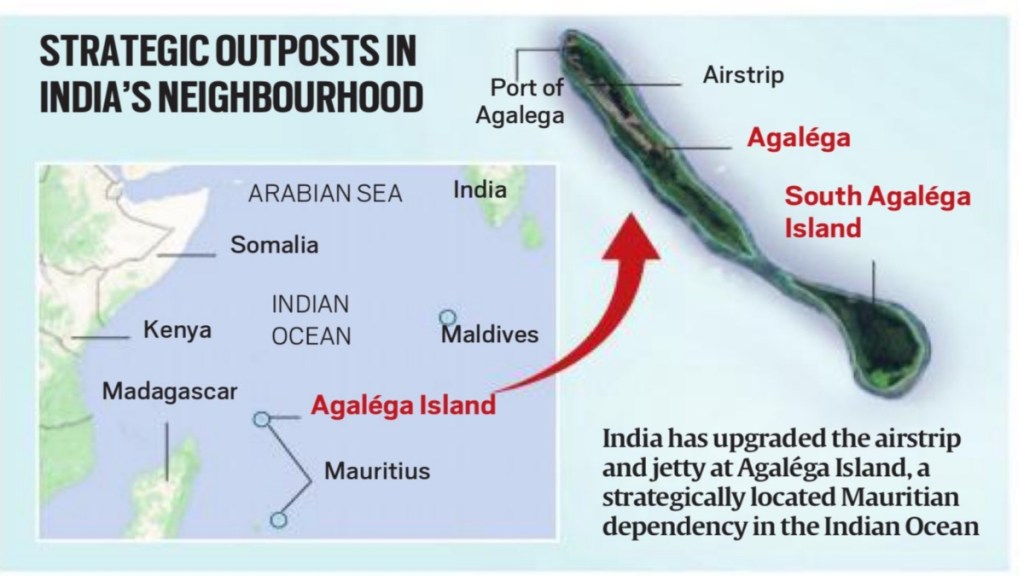By Radhey Tambi
The India-Mauritius relationship leaped forward with the virtual inauguration of an Indian-built airstrip and a jetty on the island of Agalega on February 29, 2024. The unveiling of the connectivity project by the Indian Prime Minister Narendra Modi and his Mauritian counterpart Prime Minister Pravind Jugnauth has come at a critical juncture. On the one hand, the imbroglio in the Red Sea is seeing no end with the continuous attacks on merchant shipping and subsea cables, thereby reviving piracy in the Western Indian Ocean (WIO), while on the other hand, the strategic intentions of the so-called Chinese research vessels or surveillance ships are blurring the lines between their military and non-military intentions as they continue to grow in number. Their reach to the different island nations of the region has also seen an increase. In this matrix, the Indian aid for the development projects is an attestation to India’s ‘Neighbourhood First’ and ‘Security and Growth for all in the Region’ (SAGAR) doctrine in which the island countries of the Indian Ocean occupy the quintessential centre stage.
The Republic of Mauritius, situated in the Southwestern Indian Ocean, primarily consists of two main islands, Mauritius and the island of Rodrigues. Other islands that form the outer ring of the archipelago include Saint Brandon, Chagos Archipelago (including the Diego Garcia), Tromelin, and Agalega, all situated in the western and the central Indian Ocean but not in continuity with the mainland. What brings Agalega Island into significance is its strategic location near the Mozambique Channel. The island is nearly 1060km North of the capital, Port Louis, almost 1880km Northeast of the Mozambique Channel, and 3134 km southwest of Kochi, India’s naval base in southern India.
The importance of the channel lies in the fact that it is an important trade route that facilitates the trade of billions of dollars, especially with the increasing vulnerability of the Suez Canal. The passage is also a treasure house of several metallic, non-metallic, and rare earth minerals in littoral countries like Mozambique, Tanzania, and Madagascar. This includes swathes of natural gas, iron ore, graphite, gold, rubies, Columbo-tantalates, and others. Currently, many established and emerging powers like India, China, France, the United Kingdom, Australia, Japan, and many more have already invested in various stages of production and supply chains. Further, as the need to diversify the places and sources of energy and raw materials escalates due to shifting sands in global politics, this will lead to a scramble among nations for their economic security. However, all this will require a safe and secure passage for import and export from the region.
In this context, the scattered nature of the island country, Mauritius, with an EEZ of nearly 2.3 million km2, offers an opportunity and platform for surveillance and reconnaissance around the clock and securing the trading route from both traditional and non-traditional challenges. The upgraded 3km long airstrip will facilitate larger aircraft like the P8I Poseidon to operate from it. The airstrip will assist in expanding the operational reach during peacetime and otherwise and help keep an eagle’s eye on the activities in India’s neighbourhood. The fully developed jetty would also allow larger ships to anchor at the harbour to conduct activities like search and rescue operations and humanitarian aid in and around the WIO. Additionally, this will also improve the quality of life and ameliorate the condition of the inhabitants who are cut off from the mainland due to long distances and receive an irregular supply of essential commodities from the homeland. To this end, the launch of community development projects will be an asset for the island with limited educational and medical facilities.
The development will not only strengthen the existing defence cooperation between New Delhi and Port Louis by enhancing the capability of the Mauritian Defence Forces in safeguarding their interests in the outer island regions, but it also highlights the increasing ability of India to bring the island nations within the fold of growth and prosperity. To this end, the upgradation of the surveillance infrastructure in the Western Indian Ocean is once again a testimony to the unwavering commitment of India to the maritime security architecture in its backyard as it takes a dip in Ocean affairs.
The author is Research Associate, Center for Air Power Studies (CAPS), New Delhi.
Disclaimer: Views expressed are personal and do not reflect the official position or policy of Financial Express Online. Reproducing this content without permission is prohibited).

